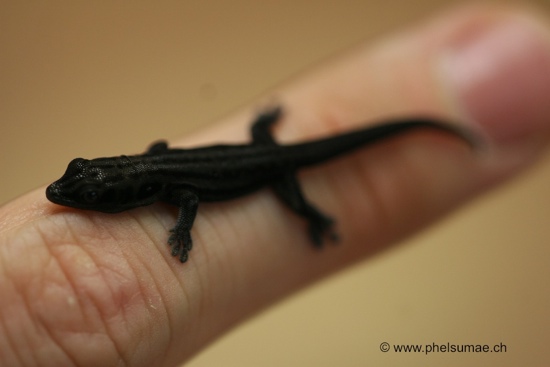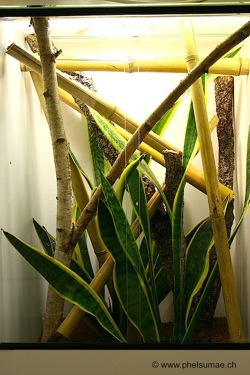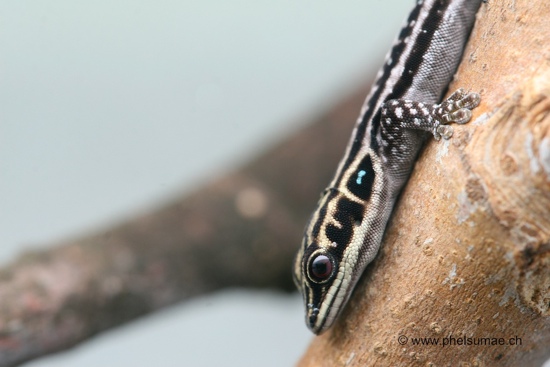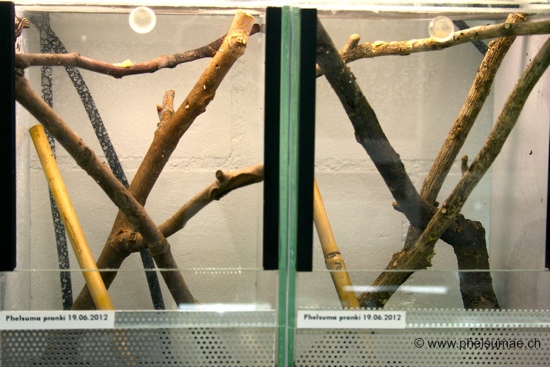Phelsuma pronki, described in SEIPP, 1994, (Senckenb. biol, Frankfurt am Main, 74, 1/2. 193rd) is named for the explorer Olaf Pronk. The gecko was originally described based on several types: the Holotype is at the Senckenberg Museum, Frankfurt am Main, Germany (SMF 75 950); the Paratype is at the Museum of Zoology, Dresden, (D 35 785).
[ad#sponsor]
Description
Phelsuma pronki reaches a size of 110 to 115mm in total length. This Phelsuma looks a lot like Phelsuma barbouri. The most obvious characteristic is the yellow colouring of the head. Depending on their mood, this identifying feature can be totally missed. The basic ventral colour is crossed by a high contrast, dark brown to blackish drawing. This looks similar to Phelsuma barbouri, however Phelsuma pronki shows more distinctive lines especially along the vertebral. A dark lateral stripe extends from the nose over the eye along the neck to the back legs. Throat, belly and the subcaudalia are white coloured. The eyes are framed in yellow, and the iris is brownish. The extremities are dark speckled. The males are distinguished by highly visible pre-anofemoral pores and a yellowish coloring in the cloacal region.

Habitat

Phelsuma pronki is only known from a few specimens in a small wooded area near Moramanga in the highland of Madagascar. In addition, there should be some more specimens about 120km further east, but there is no further information about this area.
In their native habitat, the animals live mostly hidden in the treetops. The climate corresponds on that of Perinet. This means that the temperature can easily drop down to 5 degrees celsius (41 degrees Farenheit) at night and can reach a maximum of 35 degrees (95 F) on sunny days. Since the distribution is on the east side of Madagascar, the humidity is high throughout the year.
Breeding
I keep my Phelsuma pronki in terrariums with dimensions of 50cm length x 50cm deep x 80cm high. The enclosure has a generous air space in the top, as well as in the front.
The enclosure contains branches in combination with bamboo. The planting consists mainly of Sansevieria species. It has been shown that the animals are less shy in densely planted terrariums than in clear tanks. It is therefore recommended to provide them with as many hiding places as possible. In addition, a dense enclosure is important for maintaining the humidity. I spray once a day which causes the humidity to rise above 90%, but then it falls off within a few hours to 60%. Waterlogging should be avoided.

The cages are illuminated with two T5 UV tubes, which extend over several tanks. In addition, a low-voltage halogen spot burns for a few hours a day . This allows the enclosure to reach the highest day temperature of 35 ° C below the spots. In order to conform to the temperatures in the area of their natural habitat, my tanks for Phelsuma pronki are in a special room in the basement. There it is possible to let the temperature drop strongly at night. Depending on the season and outdoor temperature the room reaches a temperature of 18 ° C in summer and 5 ° C in winter. The adults are fed twice a week with small crickets, firebrat (silverfish), waxmoths or flies. Once a month they get some fruit puree. The food items are always dusted with a vitamin and mineral compound.
For a succesful breeding of Phelsuma pronki it is important to provide the animals with a colder and drier winter phase. During this time, from October to March, the lights burn about eight hours a day. At the end of this period, the illumination time is increased gradually until it reaches about 12 hours in April . As soon as the temperatures rise,the mating season begins. The female can lay up to four clutches in a period of three to four months. Phelsuma pronki is a non gluer. It is recommended to incubate the eggs outside the enclosure, because the adults may eat their babies. Depending on the temperature of incubation the babies hatch after anywhere from 40 to 80 days and are approximately 35mm long. The hatchlings must be reared separately in small tanks with dimensions of about 15cm length x 15cm deep x 25cm hight. They are fed every two days with micro crickets and small firebrat. Once a month they get some fruit puree. The food items are always dusted with a vitamin and mineral compound. The juveniles grow relatively rapidly and reach sexual maturity at the age of about one year. But it is better to wait until the female is about 1 1/2 years old before introducing her to a male.



Simply the best Gecko Time article I’ve read in a long time, great job, Markus! Excellent, and accurate info on a rare gecko in the hobby. A real treat for us seasoned geckophiles. I enjoyed this very much, thanks again!
Thank you for your excellent article on Phelsuma pronki, Markus. I enjoyed reading it very much.
I think Phelsuma is a severely underrated group! This species is no exception.